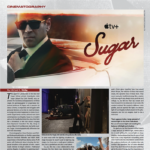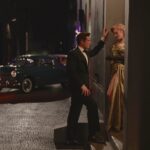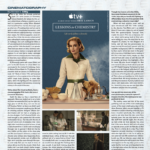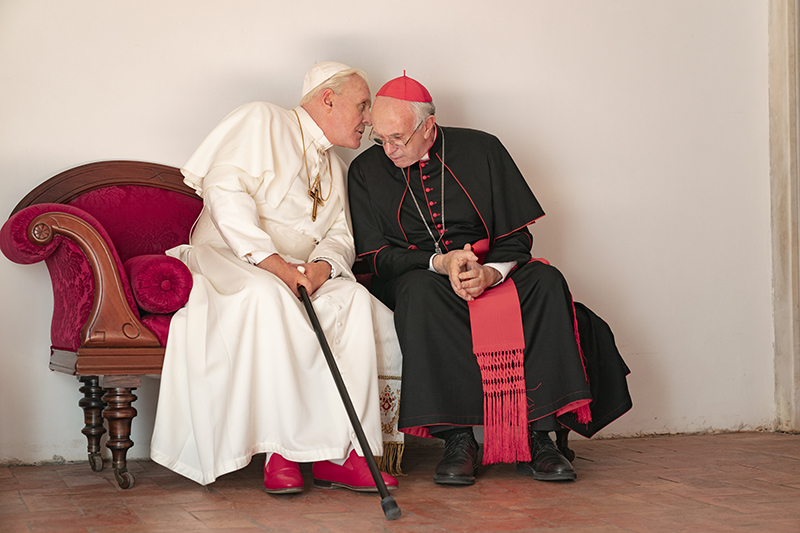
DoP César Charlone’s Vivid Colors and Projected Shadows
Directed by Fernando Meirelles and set in 2013, the recent Netflix film The Two Popes imagines a theological debate between Pope Benedict, portrayed by Anthony Hopkins, and his soon-to-be successor Francis, Cardinal Bergoglio (Jonathan Pryce), who’s hell-bent on resigning his post when the Pontiff summons the Argentinian clergyman in an effort to ascertain why.
The two religious leaders, whose philosophies occupy opposite ends of the ecclesiastical spectrum, pontificate and verbally spar on matters of church doctrine amid a swirl of headline-making scandals, which threaten to shatter the faith of millions. As Benedict wrestles with his own fateful decision to vacate his Vatical vocation — something a pope had not done in centuries — the two men gain an understanding of one another and eventually nurture a budding friendship.
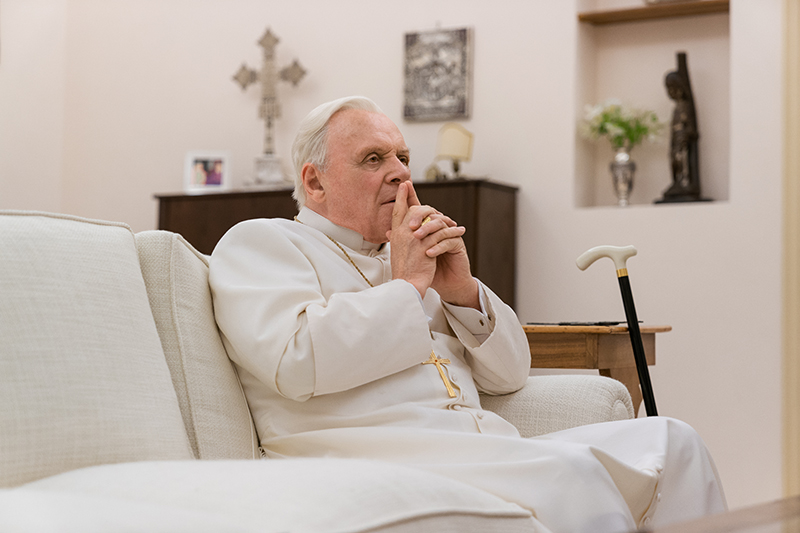
Despite the emphasis on discourse, The Two Popes is surprisingly visually brilliant, at times nearly radiant. After visiting a newly refurbished Vatican for inspiration, director of photography César Charlone envisioned a film that would illuminate the main characters and their facial expressions, as well as eradicate unnecessary and unwanted shadows, and allow the Sistine Chapel’s eye-popping color schemes to bolster the playful, at times comedic, dialogue and subtle symbolism of Anthony McCarten’s script.
Iconic Renaissance paintings, such as Michelangelo’s The Last Judgment, were reproduced for The Two Popes, as were structural components of the Sistine Chapel, contributing to the cool, almost clean, quality the filmmakers had conceptualized for portions of the Vatican. The brightness and vibrancy of these works guided Charlone throughout the production process. “Color and form were very important reference points for us when we were doing color tests for the film,” says Charlone, who collaborated with Meirelles on the critically acclaimed The Constant Gardener and City of God.
The Two Popes is but one of several auspicious signs that Netflix is heading in the right creative direction. In mid-January, Variety reported that Netflix was investing $17.3 billion in 2020 for its original streaming content. Although its 2019 fourth-quarter U.S. subscriber growth fell short of expectations, Netflix raked in nearly $5.5 billion in the same time period, beating analysts’ forecasts. The supernatural monster-hunter series, The Witcher, starring Henry Cavill, and Martin Scorsese’s Oscar-nominated The Irishman, have both been deemed successes, and feedback from The Two Popes has been generally positive across the board. The industry has also taken note: both Pryce and Hopkins had were nominated for Academy Awards for their performances in the film (Best Actor and Best Supporting Actor, respectively) with McCarten nominated for Best Adapted Screenplay.
“Working for Netflix is great,” says Charlone, a native of Uruguay. “I’m working on a documentary series for Netflix now. It’s fabulous how you interchange experiences and ideas, and how we get together. It’s a great collaboration.”

PLSN: We’re curious about the discussions you had with director Fernando Meirelles, as far as the overall look of The Two Popes. What kinds of visuals references did you use?
César Charlone: We realized, from the very beginning, that we had a dialogue-heavy film. I told Fernando the main focus should be in giving the actors the best performance situation possible. The camera should be straight on the actors, seeing every detail in their face, every gesture. I told Fernando that we cannot be doing anything fancy, moving the camera around, or doing anything that distracts. We have to see these guys with no strong shadows, no dramatic lighting that would hide part of their faces. Just have them flat lit. Simultaneously, I was searching for references for this particular look, and one of the references that came to me, since I was visiting the Sistine Chapel, was the paintings of Michelangelo and all the paintings in the ceiling — the Last Judgment. While there, I saw exactly what I was talking about: flat lighting with no shadows.
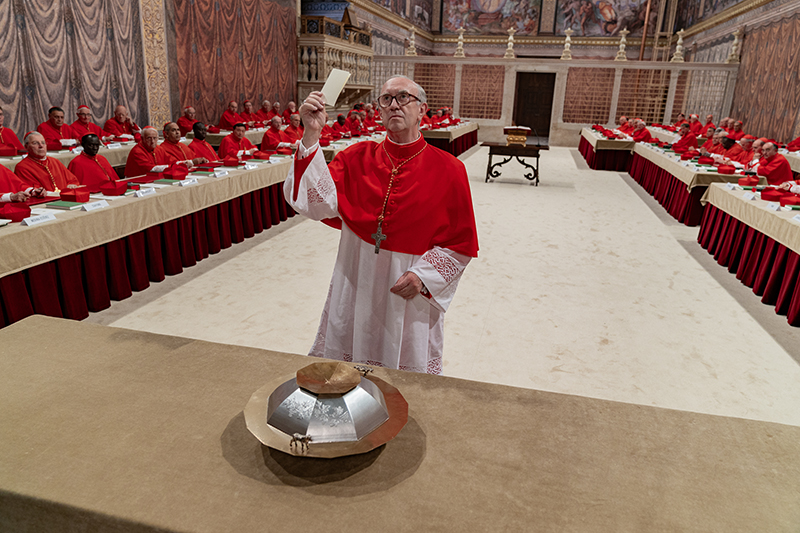
The sharpness and brightness of the film was inspired by the paintings?
Well, I wouldn’t say it was sharpness. It’s more about the actors being front-lit. It’s a dynamic process. When we were discussing this with Fernando, we were reading over the script and seeing locations. It was a work in progress.… When we were filming the scenes set in the Sistine Chapel, we wanted the actors to blend into the paintings. You have some shots when the actors are in the same room as the paintings, in the middle of discussion, and the camera is underneath, and they are almost integrated with that painting.
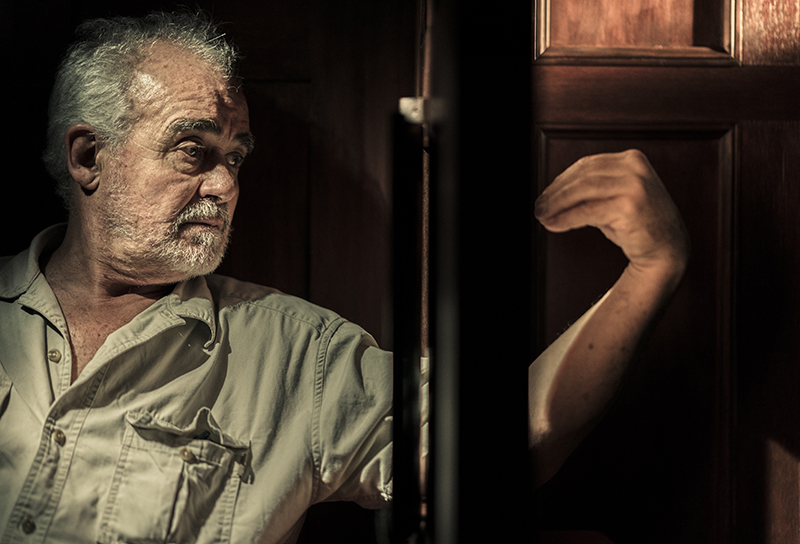
Certain rooms and scenes, in the Vatican and elsewhere, are defined by their color patterns. For instance, there was a green color scheme, more or less, in one scene…
That was Castel Gandolfo, when Francis, or Bergoglio, visited Pope Benedict. They have a long scene in the garden when they are debating and confronting each other. Then they have dinner in separate rooms, and Pope Benedict took care that Bergoglio would have the same meal, a German dish, that his mother once prepared. They ate at the same time, but not in the same room. After that, they meet in a place where, you could say, they harmonize, helped by the music of the Beatles and the dialogue. For this, I thought it would be nice to get opposite colors that would harmonize. I lit the room in green, and I lit, especially Pope Francis, Cardinal Bergoglio, in red. Red and green are opposite, but in this place they blended in a nice, soft way.
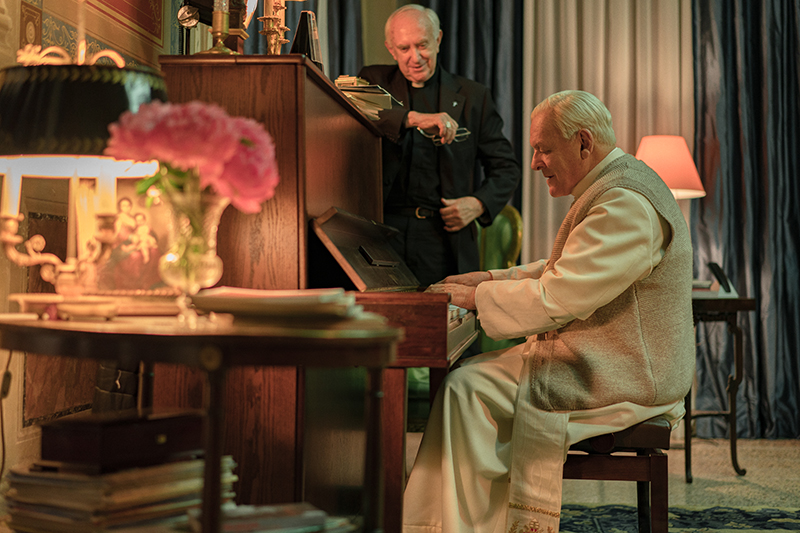
Were there other scenes in which this harmony took place?
There was a scene in which Benedict and Francis dance the tango. Benedict is dressed in white and Bergoglio is dressed in black, and so we looked to the black and white environment of the floor, and so on.
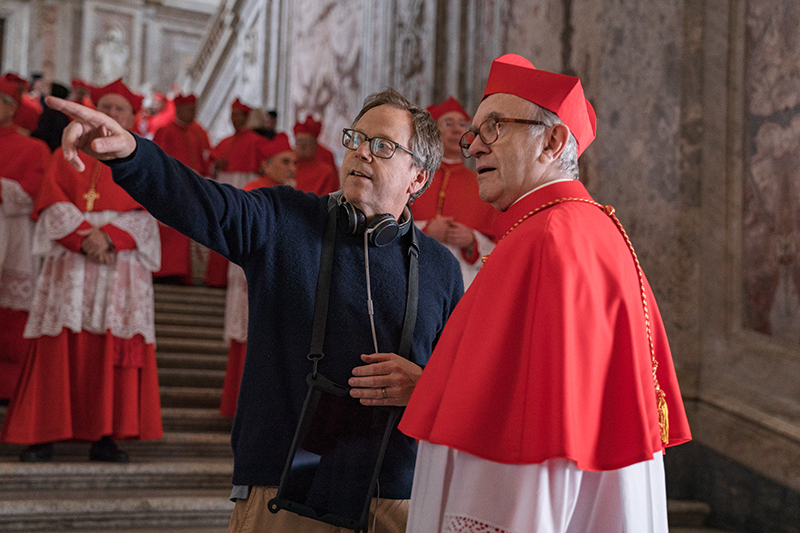
Can you speak to how the production team recreated the Vatican?
The Vatican doesn’t let film crews in, because if they would, there’d be 20 crews filming all the time. The Sistine Chapel was built in the studio, Cinecittà [in Rome]. This was marvelously done by the teams working that Enzo [Sisti, co-producer] and Mark [Tildesley, production designer]. There were lots of locations given to us to simulate the Vatican: castles and palaces that are in Italy and, specifically, Rome. The Piazza San Marco, however, was beautifully recreated in post-production.
You alluded to this earlier. The vibrancy of the color of the frescoes in the Sistine Chapel, what some have called the “Tattoo Wall,” is exceptional. How was this achieved?
Prints were done with special photographic paper. In other words, the scenario was plastered and on top of that were pictures of the Sistine Chapel. In this way, you keep the texture of the plaster. It looks exactly like a fresco. It really was perfect.
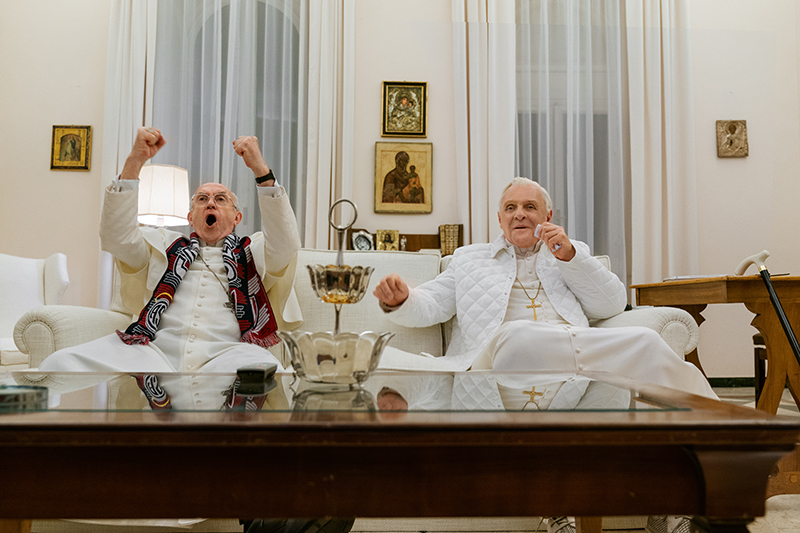
How was this lit?
I went to the Sistine Chapel quite a few times, took notes, and looked at how the sun behaved… I wanted this effect to be as realistic as possible for the film; I wanted to imitate the exact lighting in the Sistine Chapel. Because the windows are tinted, the sun doesn’t come straight onto the wall and spoil the painting. I used very strong light coming through the location of what would be the windows, and I used a filter to give the same sensation, as if light was being directed at the paintings. The strongest light is on the top, at the location of the frescoes, and at the bottom, you have a kind of spill of light coming down.
Our camera was RED Helium [sensor], an 8K camera, and we used it with two sets of different lenses. I used different zooms because I used a zoom in order to reframe … without having to change a lens or having to move the camera. I use two types of zooms: 35mm zooms, for 35mm frame, and 16mm zoom for a 16mm film. I don’t like using a 4K camera with a perfect lens for people’s skins, because you see so many realistic details that take out the softness of the imagery and the poetry. That’s why I mix these two types of lenses.
Was there anything special about the lighting units you used for this film project?
Every tool has its function. The powerful 6K HMIs are good for coming through windows, and then soft panels are good for skin … The only thing that was different was that I used film projectors to project textures or shadows on a wall. I set it up so that you’d have light, as if it was coming through the window and passing through a vitriol, and I would film that effect and project it onto the wall… If you have shadows of leaves moving just outside the window, or the sun hitting a tree and there are glittering shadows, these images are being projected onto the shade or the window. I would film that effect with my cell phone. Today you have very light and cheap projectors. I had a couple of them with me as part of my lighting equipment. I captured some real vitriols from Argentina, what was part of Bergoglio’s past, and then projected these images for our Rome scenes [in the film’s present-day year of 2013]. It helped to recall or create a kind of reminiscence of Bergoglio’s former life.
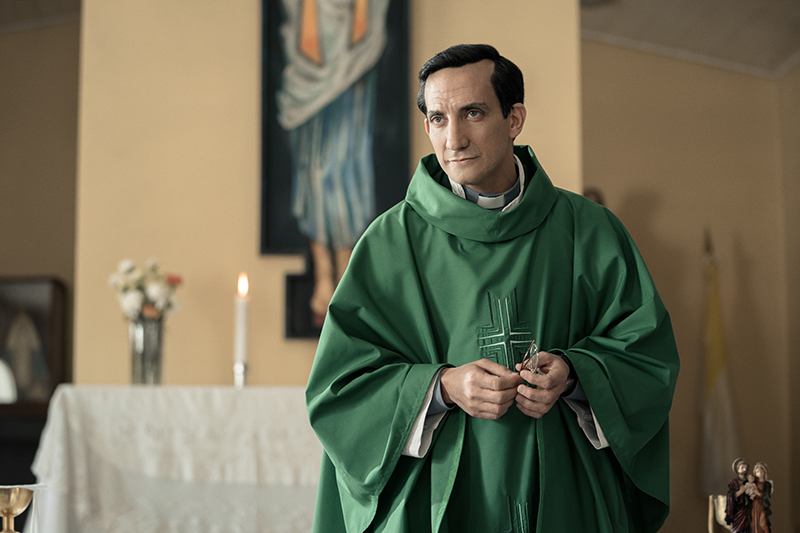
There are shifts, visually, when the film flashbacks to Bergoglio’s past in Argentina. What was done differently about these scenes?
We wanted it to be technically different from the contemporary dialogue scenes. The flashbacks would have a more filmic quality. There is some realistic archival footage used in the film, and I had to match some scenes we shot with that footage. There’s a scene done at the Plaza de Mayo in Buenos Aires, aired by the Dutch television, and we had to shoot scenes of our actress as if she were part of that archival footage. We — myself and the colorists — investigated how to get as close as possible to that footage in the way of shooting it and then afterwards in post-production.
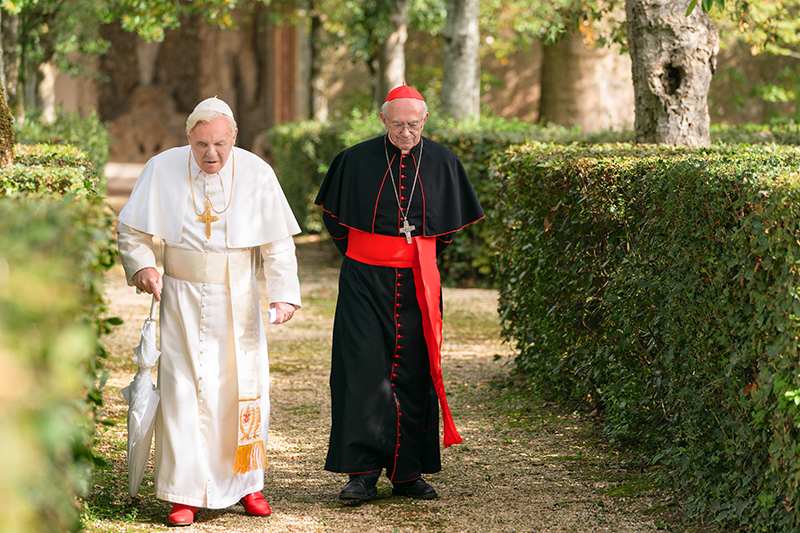
The outdoor sequences were shot where?
We filmed in Rome and in Argentina, all the flashbacks and everything.
Was it challenging to light this film, and what were some of the hurdles you faced when lighting a movie that was so focused on theological debate?
I’ll answer this way: I was a Catholic and today I am an agnostic, but I believe in the power of the church in uniting people and supporting people in their constant struggle for a better life. I was stimulated by this film. To me, it is not a film about religion but friendship. It’s about tolerance, forgiving; it’s about love. I joke that you could have done this film in a very similar way with [Cristiano] Ronaldo from Real Madrid and [Lionel] Messi from Barcelona and set it in a slightly different environment. The backdrop wouldn’t be church dogma but playing professional football [soccer]. You’d have these guys initially meet, almost as enemies, and end up as very nice friends.”
